The Blekingseka is a traditional boat that has its origins in the Blekinge archipelago near Karlskrona on Sweden’s east coast. Eka is the Swedish term for an open boat characteristic of the region, typically featuring a small, raked transom above the waterline. These boats generally have ranged in length from 14′ to 23′.
The original 14′ eka, on which today’s building plans are based, was built by Bröderna Mårtenssons Båtbyggeri (Mårtenssons Brothers Boatbuilding) on the island of Östra Hästholmen, an island 6 miles to the southeast of Karlskrona. The boat was commissioned in 1970 by Hans Hanson, a resident of the island. He had ordered it with a motor but removed that shortly after the eka was delivered to him in 1972. The eka was measured and documented by Swedish boatbuilder Bertil Andersson. His plans show how the boat would have been constructed without a motor.
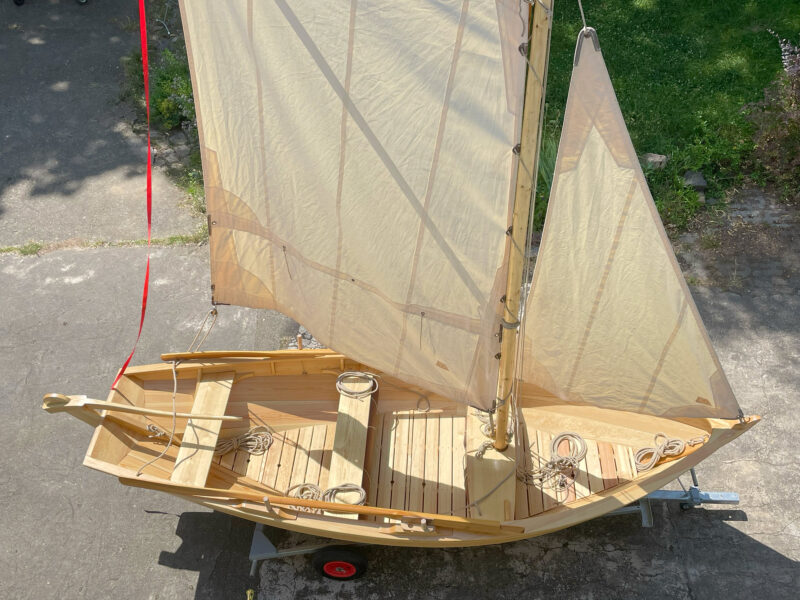 Sebastian Schröder
Sebastian SchröderThe original ekas were built of oak lapstrake planking on oak frames. I built mine glued lapstrake using 9mm Vendia plywood and pine. The construction technique removes the need for frames although I did fit timbers to support the floorboards, and hanging knees to support the gunwales.
The plans include four sheets of information about the eka’s origin and its equipment, such as oars, sails, and motor specifications. The sheets show the lines taken off by Andersson drawn at a scale of 1:10. In lieu of measured drawings or a table of offsets there is a PDF file meant to be printed out at full size (165″ × 36″) to produce full-sized patterns—with planking marked—for the keel, stem, sternpost, transom, rudder, and six frames.
The ekas were originally built entirely of oak. I decided to construct a glued-lapstrake hull using Finnish-made 9mm Vendia Marine Planking, and pine. I drew the frames as molds, which would be removed after planking, and installed floor timbers to support the floorboards, and hanging knees to support the gunwales. I used Iain Oughtred’s Clinker Plywood Boatbuilding Manual as a guide for the more contemporary construction. To facilitate the build on an upside-down frame with molds, I created a 3D model and slightly shifted the frames. I also added a removable third middle thwart to allow for rowing without interfering with the mast. Instead of using the mast stays indicated in the drawings, I opted for a slightly larger mast diameter of 90mm.
The one-piece sternpost is designed to run outside the boat below the waterline but inside the transom above the waterline, adding complexity to the construction—making it more suitable for experienced builders. Fitting the transom requires precise cutting, and the garboards have a strong twist aft. A heat gun worked very well to bend the 9mm Vendia.
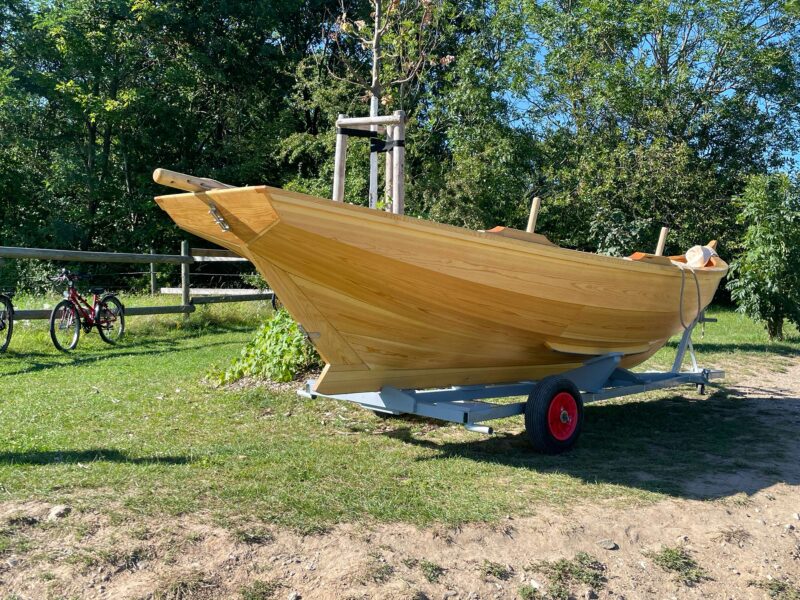 Sebastian Schröder
Sebastian SchröderThere is no centerboard or leeboard. Instead, the eka gets its fine tracking ability from its deep-V sections and its prominent keel. While not close-winded, it can comfortably tack through 120°. Its draft is only 15″ so it can be sailed in shallow water but when beached it won’t sit upright.
The finished boat is light and compact, making it easy to trailer. Rigging the unstayed 12′ 6″ mast is straightforward: the sprit mainsail remains furled and lashed to the mast, which just needs to be raised and set in a simple hole in the thwart that serves as a mast partner. The heel of the mast fits in a square hole in the transverse maststep, a block of plywood glued to the keel. The sprit has a groove at its upper end, allowing it to be set up while standing next to the trailer without needing to climb into the boat. Within 15 minutes, the boat can be launched with the mainsail set. To lower the sail while on the water, you can stand behind the mast, take the sprit out, furl the sail, and secure it.
As the open eka lacks built-in flotation, I use a set of inflatable rollers covered with fabric underneath the mast thwart and the removable middle thwart. Seating is comfortable, even on the floorboards, and the boat can accommodate up to three adults. A curved tiller allows for easy steering and is long enough for the skipper to sit well forward to balance the boat from amidships.
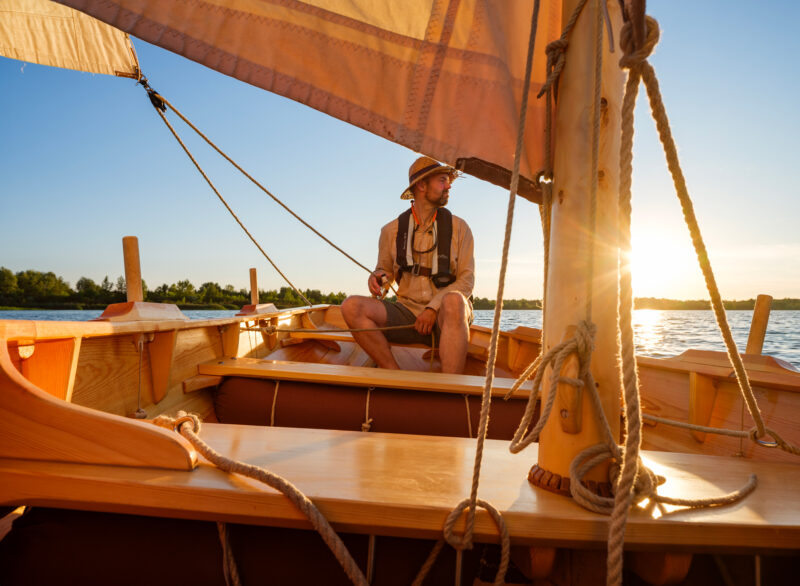 Christoph Busse
Christoph BusseThe rig is traditional and simple, the unstayed mast stands in a hole in the forward thwart. The maststep is shown in the plans as a transverse floor timber with a hole for the mast’s heel in its upper edge. There is no built-in flotation, so I tied buoyancy bags to the underside of the center and forward thwarts. The plans suggest paired thole pins for the oars, I elected to use single pins with rope grommets.
Both the main and the jib can be easily trimmed from the helm, whether you’re sitting on the middle thwart or the floorboards. The low-hanging sails can sometimes obstruct your forward view, but you can easily lift the bottom of the boomless spritsail for a better view. I especially like that the boomless sail also flaps harmlessly overhead while coming about.
Sailing this boat is a real pleasure, as it tracks beautifully. The characteristic gurgling sound of the lapstrake hull accompanies the curved bow as it smoothly rides over waves rather than cutting through them. The boat is eager to head into the wind in a gust, with almost no force needed at the tiller.
It feels fast and stable, responding immediately with moderate heeling as it accelerates. In winds of 12 to 15 knots, the boat can reach speeds of up to 5 1⁄2 knots. When pointing to windward, it maintains a speed of around 3 1⁄2 to 4 knots, as measured by the GPS. Even in 20-knot winds, the boat remains comfortable on a lake, though its performance in larger waves is yet to be tested. In winds up to 17 knots with a crew of two, the rig can be sailed with both the jib and mainsail. In stronger winds, it would be necessary to take down the jib and reef the mainsail.
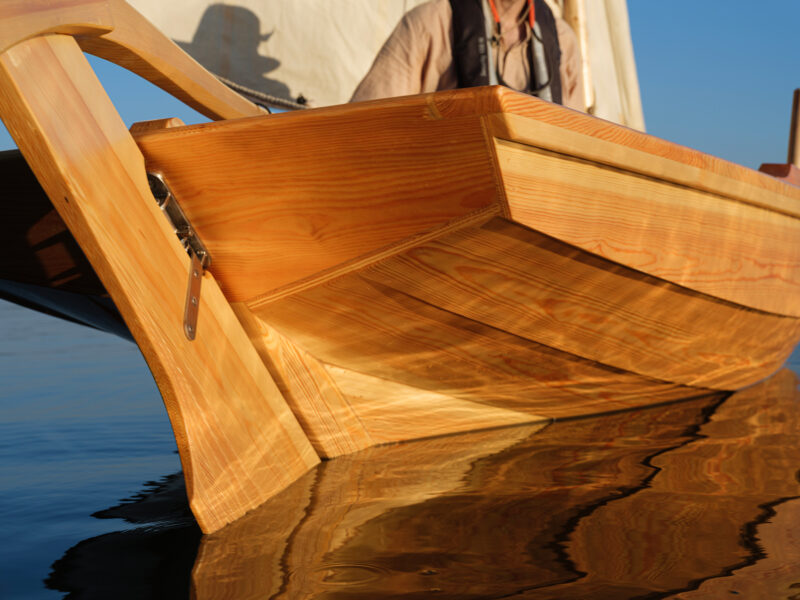 Christoph Busse
Christoph BusseThe rudder is hung on the transom and the sternpost. The fixed blade is shallower than the keel and its lower leading edge is protected by the aft end of the keel.
In moderate winds, there is minimal spray over the bow. Tacking is smooth without significantly slowing the boat, but the crew needs to be ready to balance during a jibe, as the rail can dip into the water. Counter-heeling can be easily managed by adjusting the seating position on the thwarts or sitting at the gunwale.
Instead of a daggerboard, the boat is equipped with a large rudder and a wide keel area under the transom, giving it a tacking angle of around 120°. The short hull is highly responsive to changes in longitudinal seating, so the crew must avoid sitting too far aft. For solo sailing, I would recommend adding an extra 88 lbs of ballast.
I use a single pair of Norwegian-style oars with a single wooden tholepin as the oarlock. Swedish oars with long, narrow, flat blades are specified in the plans. While sailing, the oars can be kept secured to the tholes with short lines. There are no foot braces, and with the mast standing, only one of the two rowing stations can be used comfortably.
For longer distances, a crew of two could either remove the mast or lay it down, with one person rowing from the first station and the other steering or also rowing. With a crew of three, one person would be in the bow, another rowing at the middle thwart, and the third steering at the helm. In calm waters, one person can easily row a crew of three, even with the sails set. Adding a long-shaft outboard instead of oars would crowd the small boat and require a modification to the raked transom.
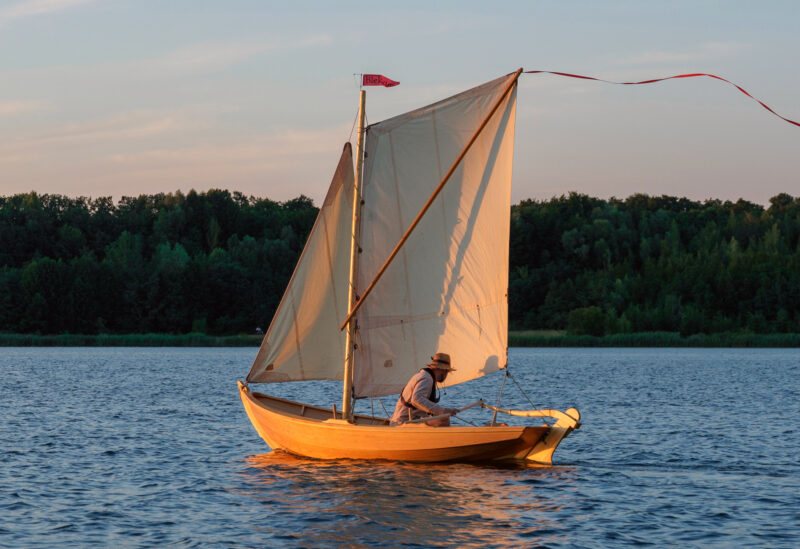 Christoph Busse
Christoph BusseWhile double-enders are common among traditional Scandinavian boats, the eka working boats of the Blekinge archipelago on Sweden’s east coast had distinctive five-sided transoms. The ekas ranged in length from 11′ to 45′.
The unique lines and small inclined transom of the Blekingseka make the building process enjoyable. Once on the water, the ease of rigging and the boat’s direct response to steering and wind make sailing an exhilarating adventure. With a draft of only 15″ when empty, my boat can be beached bow-first on a sandy shore and heel over on the bilge rubbing strips I added. The Blekinge Eka is best suited for protected waters and will appeal to builders with small workshops or limited storage space who have some prior experience in boatbuilding. The boat is most enjoyable when sailed by a crew of two and, with the absence of a daggerboard, even a family of three can be comfortable.![]()
Sailing the Baltic Sea became a dream for Sebastian Schröder while kayaking around the Danish island of Bornholm in 1996. Since then, coastal cruising in small, open, traditional wooden boats has become a passion. Living close to Leipzig in the southeast of Germany, he frequently sails the nearby region of Neuseenland where old open-pit coal mines have been flooded to create lakes. His work as an illustrator in creativity workshops and conferences gives him the opportunity to sail and kayak the Baltic Sea and to build wooden boats in traditional Scandinavian style as Feinspiel.
Blekingseka Particulars
Length: 14′
Beam: 57 3⁄4″
Draft: 15″
Sail area: Main 60 sq ft Jib 22 sq ft
Plans for the 14′ Blekingseka are available from Boat Plans by Bertil Andersson for 600 Swedish Krona (about $59 USD).
Is there a boat you’d like to know more about? Have you built one that you think other Small Boats readers would enjoy? Please email us your suggestions.
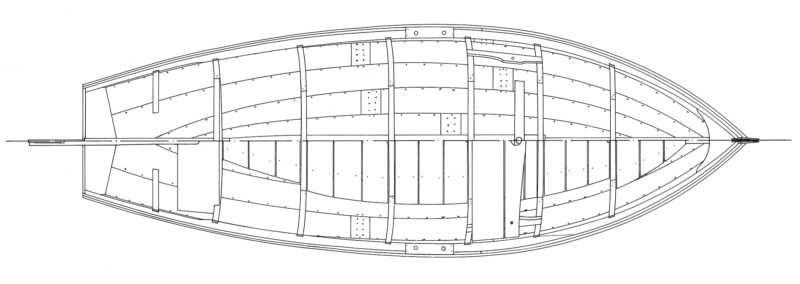
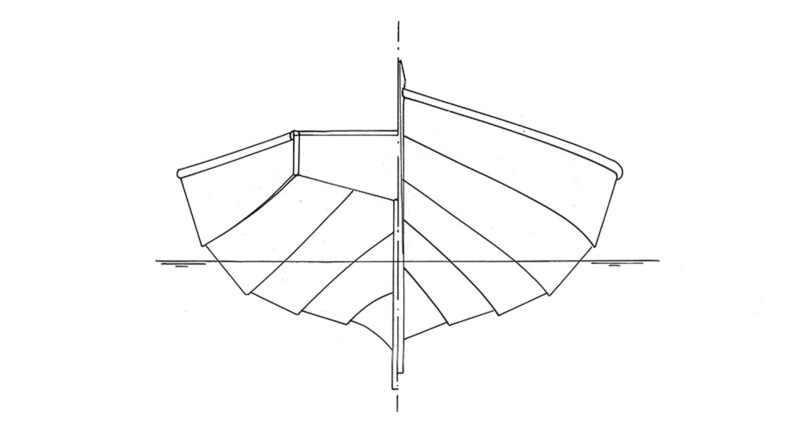
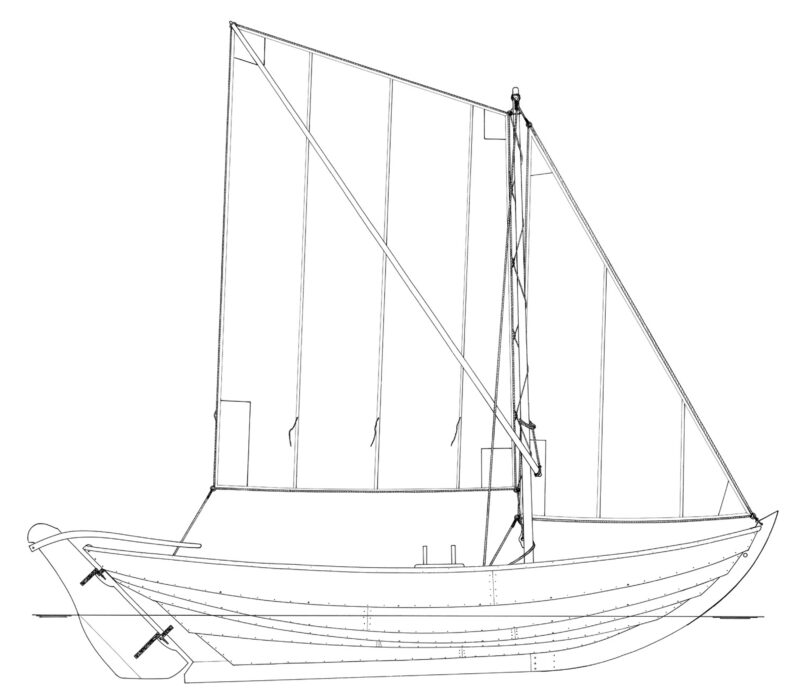

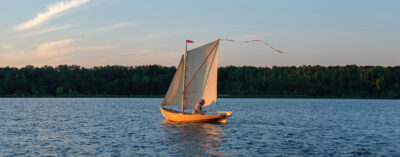
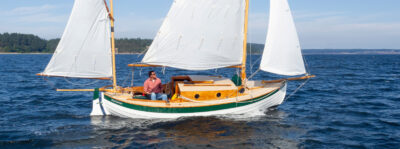
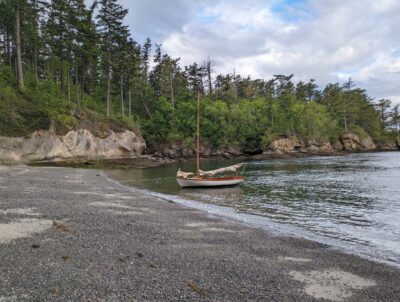


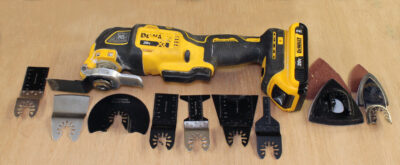
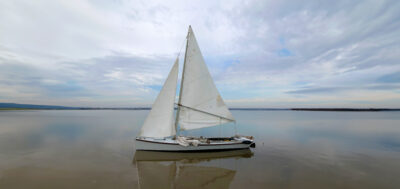
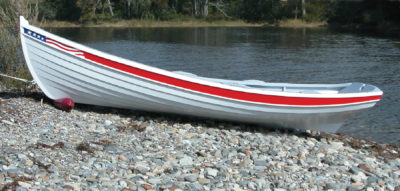
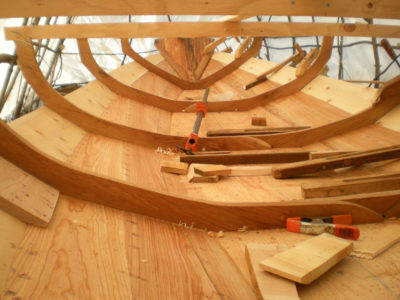
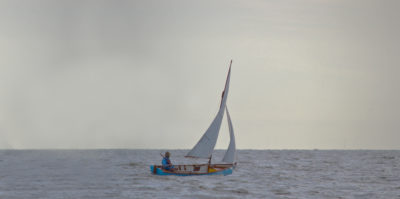
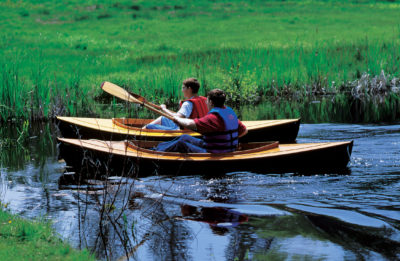
My fascination: how to build a Blekinge Eka. Could you take me through the process? Would be great fun. We have one to repair – and the narrow transom is …. narrow. What is Vendia Marine planking? Sounds attractive. Is it expensive? Sail plan?
All the best!
Hi Olof, thanks for your interest. I have built this Eka in a modern way: It is glued lapstrake. I have some experience in building boats using that method way (designing and building 4 boats so far). I could possibly guide you through the process or at least give you some advice, where are you situated?
The narrow transom is also special in the way of building and repairing.
Vendia Marine planking is a type of boatbuilding plywood made of local Finnish pine. The layers for the boards are cut in slices from the log and look like wooden planks. The material is more expansive than okoume plywood but is very nice to work with in terms of (steam-) bending, cutting, and sanding. The original sail plan is in the plans I bought, but I modified them to have a bigger sail area.
All the best!
The Blekinge archipelago in the southeast of Sweden is home to the Blekingseka and many still abound in the area. Their correct name, Blekingseka, is from “bleke” and “eka”, where eka means small boat and bleke means sheltered waters with no wind, conditions that are often found in the archipelago.
Hi Thomas thank you for explaining the origin of the name.
That is a beautiful hull and a nice job of building. No opportunity to hide errors with a varnished hull. With most of the lateral resistance aft does it track well?
Hi Ronald, thank you. I often sail small boats and am used to correcting course with any slight change of wind, passenger distribution, or heel. The Blekingseka sails so easily and tracks so well, that I find I’m concentrating more on the conversation than on keeping the boat’s course, and we’ve stayed on course, even, twice, in the dark…if there’s moonlight and wind I try to be on the water.
Beautiful boat! And beautiful finish! I am curious what you used that kept it so light. The varnishes and oils I use on furniture all darken the wood. Only lacquers & water based finishes remain light.
Hi, the finish is done with “Le Tonkinois Marine No. 1. The first 6 layers are varnish only and the last two layers are mixed 1:1 with Gelomat to get a matte finish. Le Tonkinois Marine No. 1 has a special UV light protection and gives a light and golden finish at the pine verniers of the Vendia boat planks. It is linseed oil based and behaves like a thin oil.